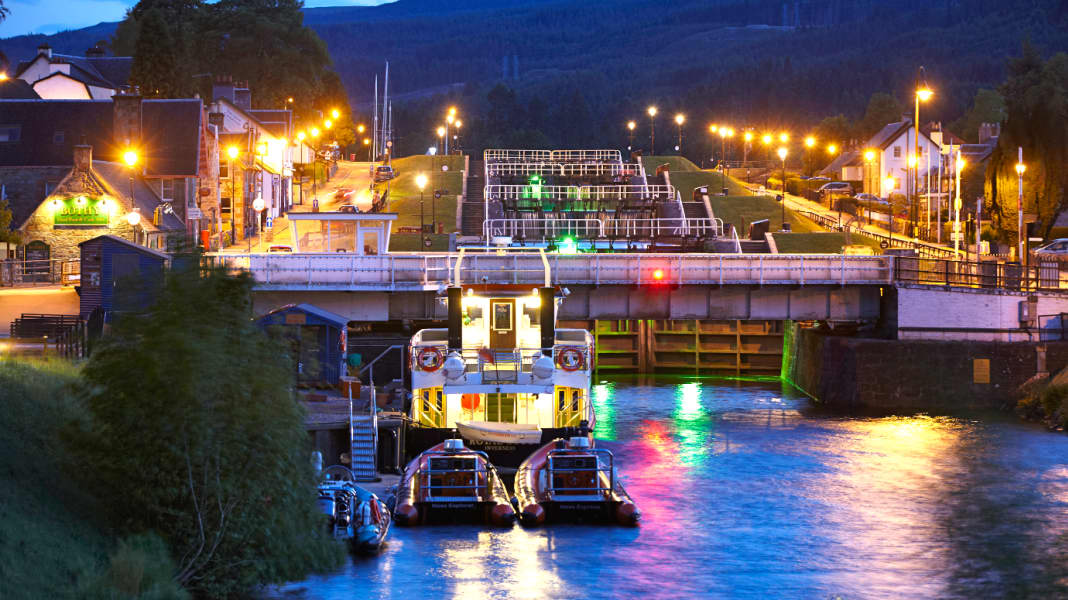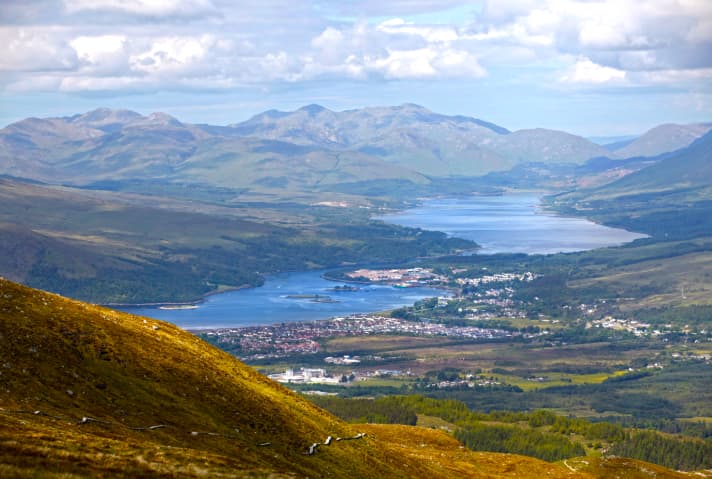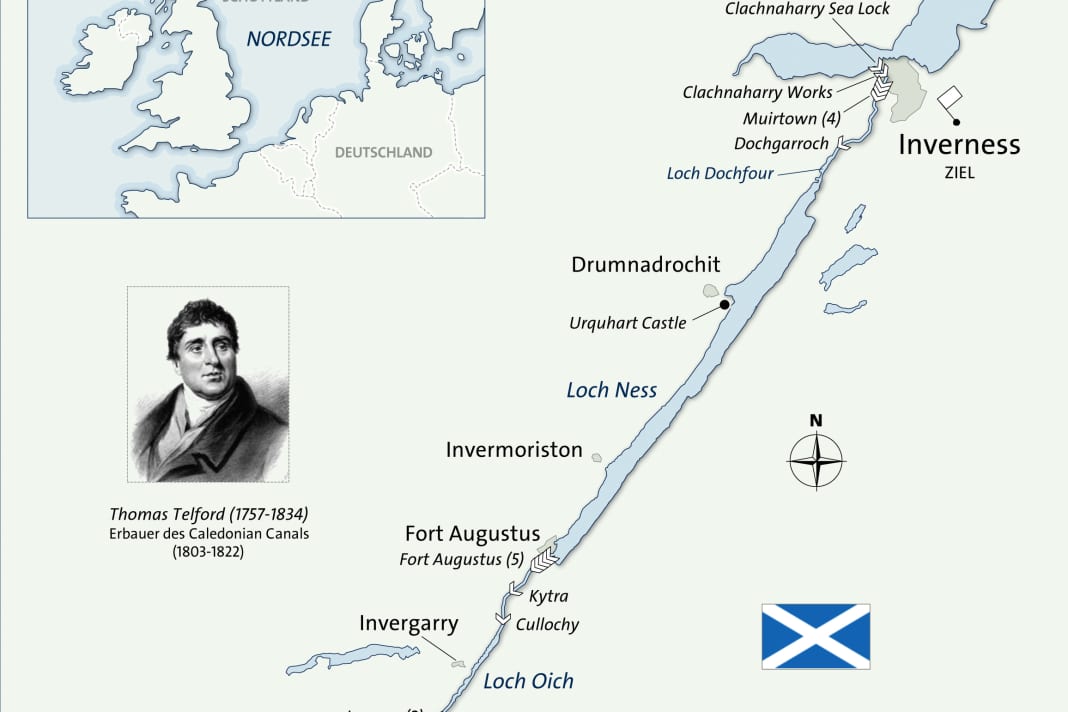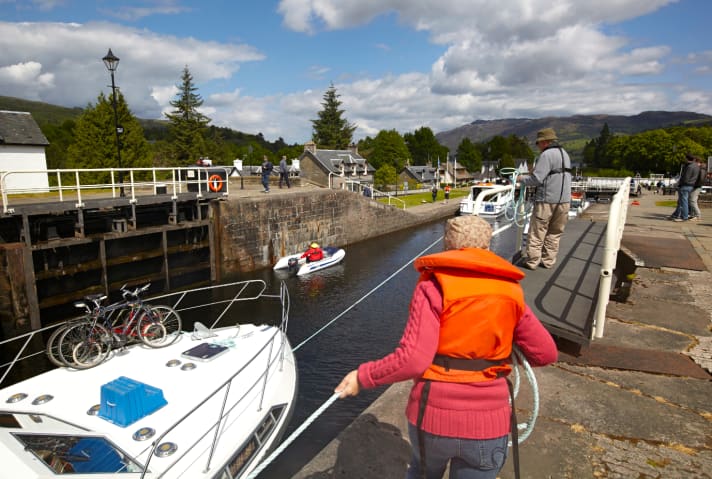







They had all come who had something to say in the Great Glen, the Frasers, the Grants and the MacDonnells of Glengarry, landowners, engineers and civil servants. Their bare knees were red under their woollen kilts, for 24 October 1822 had been a cold, windy day in the Scottish Highlands, especially on the deck of a steam yacht on the open Loch Ness. This had not dampened the mood - they had simply been too proud of what they had achieved together - or, in view of the thousands of labourers involved, had allowed to be achieved ...

On this day, after a construction period of 19 years, the Caledonian Canal was opened. This masterpiece of engineering now cut through the Highlands, a hitherto largely untapped and still wild region, and connected the Atlantic at Fort William with Inverness on the North Sea. Cargo ships up to a proud length of fifty metres could now travel from one sea to the other in just a few days - and avoid the several hundred nautical mile diversions around the north of Scotland; waters that were more notorious and feared by sailors than any other corner of the British Isles due to their raging tidal currents and bad-tempered weather.

A route made for you
The new canal followed a relatively "simple" route: the Great Glen cut through the Highlands like a deep notch; only 35 artificial kilometres of canal were needed to connect both coasts and the four elongated lakes in between to form a continuous waterway. Nevertheless, six million tonnes of earth had to be moved with picks and shovels and thousands upon thousands of granite blocks had to be quarried, hewn and built into locks, bridges and harbour walls - a laborious task that ultimately took twelve years longer than master builder Thomas Telford had originally planned.
However, they were all the prouder on the day of the opening, and when everyone gathered for dinner that evening after the first canal passage, the event was celebrated in good Scottish tradition with a whole litany of toasts. No fewer than 39 glasses were raised - with whisky, of course ...
"Welcome to the Caledonian Canal", says the sign at the sea lock in Corpach - the place where, almost 200 years ago, the humourous dinner party just described took place. A footpath next to the chamber leads through thorny undergrowth down to the shingle beach, where the salt water of Loch Linnhe washes over the stones. Even if you can't see the open sea from here, the 60 kilometre long fjord opens out onto the Atlantic further to the south-west.
The Great Glen, on the other hand, leads to the north-east, between the barren ridges of the Highlands with their wind-swept flanks, whose green shines brightly when the sun finds a way through the rain-heavy cloud towers above us. Our own journey across Scotland begins in the middle of this postcard panorama - by dinghy and tent.
Start in Corpach on Loch Linnhe
Our first stop is the canal office at the harbour basin between Corpach Sea Lock and the first double lock. Inside, we are greeted by two friendly British Waterways Scotland employees, a registration form is already waiting on the counter. We pay just under 65 British pounds for a licence valid for seven days - just under 80 euros. Additional days would cost an extra £1.20 per metre, payable on arrival in Inverness. On top of that, we get a water licence. We are allowed to leave our Sharan in the lock car park. "If you haven't picked it up in a fortnight, we'll know you've been caught by the Loch Ness monster," we are told with a laugh: "The beast likes rubber!"
At the waiting jetty above the double lock at Corpach, we launch the 3.60 m Grand Corvette C 360, attach our trusty 15 hp two-stroke Yamaha to the stern and stow, press and brace until all the equipment is stowed away, from the spare canisters, tent and sleeping bags to the camping cooker, spare propeller and photographic equipment. Now we are just waiting for our previously announced "companion" for the stage: a Norwegian sailing yacht, which will join us over the first lock staircase in Banavie. A cosy cup of Darjeeling later, the "Stina", a steel ketch from Bergen, has caught up with us. We let the "lady" go first and start our journey towards the North Sea
However, "Neptune's Staircase" comes into view after just one bend - and it lives up to its name: the god of the sea could climb around twenty metres higher in one go via eight steps (i.e. successive lock chambers). We'll take care of that in this case. The swing bridge and bottom gate of the first chamber are already open and we can enter immediately. The iron gates are massive and weigh several tonnes - they were only automated in 1969. Before the magic of electricity and hydraulics came to the Caledonian Canal, only the muscles of the ship's crews and lock keepers counted, sweating together on the capstan and spill to make things go faster. Gate wing by gate wing, stair step by stair step.
As we make our way up chamber by chamber and the gates close behind us and open in front of us, we strike up a conversation with the Norwegians. The five young lads all look like true Vikings - which is largely due to the fact that they haven't shaved since the start of the journey in Bergen. That was four weeks ago, in the meantime they have sailed the northern route, via the Orkneys and the Scottish west coast down to here. "We're now heading back across the Channel to the North Sea and home," they tell us. A popular round trip in Norway. However, the weather was very bad.
"Was it still worth it?" we ask. "Of course," comes out of one mouth, "the beer is cheaper than here!"
Ben Nevis and Loch Lochy
The western part of the Caledonian Canal lies in the shadow of Britain's highest mountains. The mightiest of these, Ben Nevis, rears its bald head to a height of 1344 metres and attracts hikers, climbers and off-road bikers all year round, for whom Fort William is the starting point. Neighbouring Aonach Mòr is much easier to climb - thanks to the only cable car in the British Isles. After the fully glazed suspension ride, the mountain station offers spectacular views at an altitude of 800 metres: of the Great Glen with the hair-thin silver band of the canal - to Loch Linnhe in the west and Loch Lochy in the east - and to the north over the barren ridges of the Highlands.
The classictea time is long gone when we leave the lock at Gairlochy and reach the first of the great lochs: Loch Lochy, which stretches for almost 15 kilometres in the valley of the Glen. The sky above us has long since turned a solid grey and continues to descend. But there is hardly any wind. We say goodbye to the Norwegians for now and step on the gas. Soon the spray flies over the oily surface of the lake on both sides; the wake runs out wide. The shore passes by in darkness as we glide north-eastwards. It's time to find a place to spend the night.
We had been given a tip in Banavie: As we waited in the last chamber of "Neptune's Staircase" for the gate to open, we struck up a conversation with a couple from Halle who had leant their heavy rucksacks against one of the old piles and were watching the lock: The previous night, the pair had pitched their tent at the northern end of Loch Lochy, on a shallow gravel bank on the shore.
A pub on the water
We actually find the spot, but it's almost too shallow to land, even with the engine up. We're about to give up when we come across a slightly deeper channel with enough water for us to row to the shore. The location is good, but the stony ground is not particularly flat. However, the country road that runs alongside the lake is out of sight at this point. The tent is quickly pitched - and then we set off on foot. Because the two backpackers had a second piece of
good advice for us ...
A short walk through a pine grove close to the bank brings us back to the canal and the Laggan double lock. This is where the "Eagle Barge Pub" is located - but not on land, but on the water: in the steel belly of an old barge that toiled on the Rhine and Waal in its "first life". The gangway takes you on board. "Come in & get warm" is written on the polished wooden door of the companionway. We don't need to be told twice!
Inside, over cask ale from the Isle of Skye, we quickly get chatting to other crews: Who we were, where we came from and - again and again - whether we didn't mind the midges in our open boat. The tiny, flying bloodsuckers are also known as the "scourge of the Highlands"; as inconspicuous as they are persistent, they leave very itchy spots when they bite. We proudly point to our deterrent potential: Jungle Milk, Autan and reasonably insect-proof clothing. The best thing to help, however, is the wind, because even a light breeze can keep the lightweights on the ground - and there's no shortage of that in Scotland, even in summer.
Over Loch Oich to Fort Augustus
Together with two charter boats, we pass the two lock chambers of Laggan and the "Eagle Barge Pub" the next morning, followed by Loch Oich. The loch is much shallower than Loch Lochy, so a dredged and marked channel runs from one end to the other. It's a relaxed day in light sunshine; we don't feel rushed and take advantage of a narrow beach sheltered by flowering gorse bushes for breakfast with a view. We have scones and cheddar from Fort William, with coffee from an aluminium bag.
A little further along the shore, we see the ivy-covered walls of Glengarry Castle rising out of the trees. A very special kind of houseboat is anchored in front of it: a wooden fishing boat with colourful flower boxes from stem to stern. Its bearded occupant gives us a friendly wave.
The wind picks up as we leave the loch and pass through the locks at Cullochy and Kytra on the next stretch of canal. The Caledonian Canal's apex with Loch Oich is behind us and the next set of locks is already waiting - Fort Augustus, at the south-west end of Loch Ness. We moor the dinghy at the waiting point in the upper water and register with one of the lock keepers. It will take a while - two sailing yachts and a trawler from Aberdeen have just made their way up.
We use the time for a first tour. Without our heavy jackets, we stroll along the five lock chambers; the cosy village with its 600 inhabitants lives from tourism and the canal is its biggest attraction. It is correspondingly lively: playing children, frolicking dogs and bulging picnic baskets share the lawns on both sides of the lock stairs, a bagpiper provides the loud background music with his bagpipes: Mull of Kintyre, Men of Harlech, Auld Lang Syne. From a stone pier, we can see far out over Loch Ness: blue water and whitecaps. But we wanted to stay in Fort Augustus that day anyway. "Scots Kitchen still has a B&B room available for us, and the Lock Inn looks like the perfect evening entertainment.
The final highlight: Loch Ness
Now for the final highlight of our trip (and the biggest challenge for our dinghy): Loch Ness itself. The loch is 37 kilometres long and up to 230 metres deep - enough space for any monster to hide from prying eyes for decades to come. In any case, we can't capture even the fuzziest humpback in a photo. Our problems look completely different anyway: Although the wind has shifted back to the north-west, it is still blowing so strongly that the short waves are battering us one after the other, even below the shore. Gliding is out of the question, but we still get wet from the spray. Our thermos flask has long since been emptied when, after three hours, we spot the ruins of Urquhart Castle, whose weathered battlements form the most famous landmark on Loch Ness.
We moor in the well-protected guest harbour of Urquhart Bay, change our clothes and take a bus to the castle. We make our way through tour groups and school classes through the entrance area and out onto the open-air grounds between the once impressive walls of the medieval complex. We are drawn to the Grand Tower, which has largely escaped the ravages of time. We climb the wooden steps to the top platform, where someone has stuck a small Scottish flag with a St Andrew's cross into a crack in the wall.
Loch Ness lies below us, its northern end can already be recognised. Tomorrow we will tackle the last twenty kilometres to Inverness, pass the last lock staircase in Muirtown and conclude our trip across the fascinating Highlands at the stone pier of the Sea Port Marina. And then we will toast to this, in good Scottish tradition, as the builders of the Caledonian Canal once did - with at least one good Scotch whisky ...

